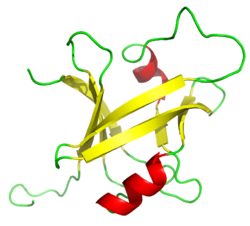Biology:B3 domain
The B3 DNA binding domain (DBD) is a highly conserved domain found exclusively in transcription factors (≥40 species) (Pfam PF02362) combined with other domains (InterPro: IPR003340). It consists of 100-120 residues, includes seven beta strands and two alpha helices that form a DNA-binding pseudobarrel protein fold (SCOP 117343); it interacts with the major groove of DNA.[1]
B3 families
In Arabidopsis thaliana, there are three main families of transcription factors that contain B3 domain:[2]
- ARF (Auxin Response Factors)
- ABI3 (ABscisic acid Insensitive3)
- RAV (Related to ABI3/VP1)
| protein | ARF1-B3 | ABI3-B3 | RAV1-B3 |
|---|---|---|---|
| B3 structure derived by | molecular model[1] | molecular model[1] | NMR[1] |
| B3 recognition sequence | TGTCTC[3][4] | CATGCA[5][6] | CACCTG[7] |
PDB: 1WID[1] and PDB: 1YEL[8] are only known NMR solution phase structures of the B3 DNA Binding Domain.
Related proteins
The N-terminal domain of restriction endonuclease EcoRII; the C-terminal domain of restriction endonuclease BfiI possess a similar DNA-binding pseudobarrel protein fold.[9][10]
See also
- Restriction endonuclease EcoRII
- Auxin
- Abscisic acid
References
- ↑ Jump up to: 1.0 1.1 1.2 1.3 1.4 "Solution Structure of the B3 DNA Binding Domain of the Arabidopsis Cold-Responsive Transcription Factor RAV1". Plant Cell 16 (12): 3448–59. 2004. doi:10.1105/tpc.104.026112. PMID 15548737.
- ↑ "Arabidopsis transcription factors: genome-wide comparative analysis among eukaryotes". Science 290 (5499): 2105–10. 2000. doi:10.1126/science.290.5499.2105. PMID 11118137. Bibcode: 2000Sci...290.2105R.
- ↑ "ARF1, a transcription factor that binds to auxin response elements". Science 276 (5320): 1865–8. 1997. doi:10.1126/science.276.5320.1865. PMID 9188533.
- ↑ "The Roles of Auxin Response Factor Domains in Auxin-Responsive Transcription". Plant Cell 15 (2): 533–43. 2003. doi:10.1105/tpc.008417. PMID 12566590.
- ↑ "The conserved B3 domain of VIVIPAROUS1 has a cooperative DNA binding activity". Plant Cell 9 (5): 799–807. 1997. doi:10.1105/tpc.9.5.799. PMID 9165754.
- ↑ "Transactivation of the Brassica napus napin promoter by ABI3 requires interaction of the conserved B2 and B3 domains of ABI3 with different cis-elements: B2 mediates activation through an ABRE, whereas B3 interacts with an RY/G-box". Plant J. 24 (1): 57–66. 2000. doi:10.1046/j.1365-313x.2000.00857.x. PMID 11029704.
- ↑ "RAV1, a novel DNA-binding protein, binds to bipartite recognition sequence through two distinct DNA-binding domains uniquely found in higher plants". Nucleic Acids Res. 27 (2): 470–8. 1999. doi:10.1093/nar/27.2.470. PMID 9862967.
- ↑ Waltner, J.K.; Peterson, F.C.; Lytle, B.L.; Volkman, B.F. (2005). "Structure of the B3 domain from Arabidopsis thaliana protein At1g16640". Protein Sci 14 (9): 2478–83. doi:10.1110/ps.051606305. PMID 16081658.
- ↑ "Crystal structure of type IIE restriction endonuclease EcoRII reveals an autoinhibition mechanism by a novel effector-binding fold". J. Mol. Biol. 335 (1): 307–19. 2004. doi:10.1016/j.jmb.2003.10.030. PMID 14659759.
- ↑ "Structure of the metal-independent restriction enzyme BfiI reveals fusion of a specific DNA-binding domain with a nonspecific nuclease". Proc. Natl. Acad. Sci. U.S.A. 102 (44): 15797–802. 2005. doi:10.1073/pnas.0507949102. PMID 16247004. PMC 1266039. Bibcode: 2005PNAS..10215797G. http://bib-pubdb1.desy.de/record/138680/files/2005_Grazulis_15797.pdf.
External links
- DBD database of predicted transcription factors "DBD: a transcription factor prediction database". Nucleic Acids Res. 34 (Database issue): D74–81. 2006. doi:10.1093/nar/gkj131. PMID 16381970. Uses a curated set of DNA-binding domains to predict transcription factors in all completely sequenced genomes
- Classification in the "Transcription factors" table according to the Transfac database.
- Database of Arabidopsis Transcription Factors
- B3 , RAV, and ARF family at PlantTFDB:Plant Transcription Factor Database
 |


